Bio Protocol52
Bio Protocol52
Uploaded by
RCopyright:
Available Formats
Bio Protocol52
Bio Protocol52
Uploaded by
ROriginal Title
Copyright
Available Formats
Share this document
Did you find this document useful?
Is this content inappropriate?
Copyright:
Available Formats
Bio Protocol52
Bio Protocol52
Uploaded by
RCopyright:
Available Formats
http://www.bio-protocol.
org/e52 Vol 1, Iss 7, Apr 05, 2011
Standard DNA Cloning
Fanglian He
Carnegie Institution at Stanford
[Abstract] This protocol describes general cloning steps from preparation of both vector and
insert DNA to the ligation reaction.
Materials and Reagents
1. Luria-Bertani broth (LB) medium: Bacto-tryptone (BD Biosciences), yeast extract (BD
Biosciences)
2. Antibiotics (Sigma-Aldrich/Thermo Fisher Scientific)
3. QIAGEN Plasmid Purification Handbook (QIAGEN)
4. SeaKem® LE Agarose (Cambrex)
5. Plasmid Prep Kit (QIAGEN /Fermentas)
6. PCR Clean-up kit (QIAGEN /Fermentas)
7. Restriction enzymes (New England Biolabs)
8. Alkaline Phosphatase: Calf intestinal alkaline phosphatase (CIP) (New England Biolabs,
catalog number: M0290) or Shrimp Alkaline Phosphatase (SAP) (Promega Corporation,
catalog number: M8201)
9. Ligase enzyme (New England Biolabs)
10. DNA ladder
11. NaCl
12. LB broth media (see Recipes)
13. Ligation reaction (see Recipes)
Equipment
1. Nanodrop (Thermo Scientific)
Procedure
A. Preparing vector DNA for cloning:
Depending on the copy number of the vector plasmid, decide if you need the Mini-prep, Midi-
prep, or Maxi-prep kit. If it is a high copy (>10 copies/cell) plasmid, plasmid DNA can be
Copyright © 2011 The Authors; exclusive licensee Bio-protocol LLC. 1
http://www.bio-protocol.org/e52 Vol 1, Iss 7, Apr 05, 2011
prepared by using the Mini-prep kit. If it is a low copy (<10 copies/cell) plasmid, use the Midi-
prep or Maxi-prep kit.
1. Grow E. coli cell culture carrying vector plasmid in LB liquid medium with appropriate
antibiotics at 37 °C overnight.
2. Follow QIAGEN Plasmid Purification Handbook to obtain DNA. If plasmid DNA does not
need to be purified, and to be more economical, plasmid DNA can be extracted without
using a plasmid prep kit (See protocol “Plasmid DNA extraction from E. coli using alkaline
lysis method”).
3. Estimate plasmid DNA concentration using one of the following two ways:
a. Load 2-3 μl plamid DNA and a DNA ladder on a DNA agarose gel and estimate DNA
according to the DNA marker.
b. Easier and more accurate way is to measure DNA using Nanodrop if it is available.
4. Digest 2-5 μg vector DNA using restriction enzymes needed for the insert DNA. To make
sure the vector is completely digested, extra enzyme and long incubation may be needed.
5. To reduce the chance of self-ligation, dephosphorylate the 5′ phosphorylated ends of the
digested vector with alkaline phosphatase.
Note: If the shrimp alkaline phosphatase (SAP) is used, then add 2 μl SAP directly to 100
μl digest solution, incubate at 37 °C for 1 h, then inactivate SAP at 65 °C for 10 min. If the
calf intestinal alkaline phosphatase (CIP) is used, then add 5 μl CIP enzyme to 100 μl
digestion solution, incubate at 37 °C for 1 h, then inactivate SAP at 65 °C for 30 min.
6. Perform gel purification of digested vector DNA.
B. Preparing insert DNA for cloning:
1. Obtain insert DNA from digestion of plasmid DNA.
a. Extract plasmid DNA as described above.
b. Digest plasmid DNA with appropriate restriction enzymes.
c. Perform gel purification of insert DNA.
2. Generate insert DNA from PCR product.
a. Design primers using a free a good quality program online (e.g.,
http://frodo.wi.mit.edu/primer3/) containing desired cloning sites with several of bases
flanking their recognition sequences
(http://www.neb.com/nebecomm/tech_reference/restriction_enzymes/
cleavage_olignucleotides.asp).
b. Amplify insert DNA from a template by PCR, and clean up PCR product by PCR
clean-up kit.
Copyright © 2011 The Authors; exclusive licensee Bio-protocol LLC. 2
http://www.bio-protocol.org/e52 Vol 1, Iss 7, Apr 05, 2011
c. Digest PCR product with the corresponding restriction enzymes. Or, first clone PCR
product to pGEM T-easy vector, and then generate insert DNA from the resulting
plasmid.
d. Perform gel purification of insert DNA.
e. Estimate DNA concentration.
C. Ligation of insert and vector:
a. Usually (particularly for blunt end ligation), need more insert DNA than vector: 1 mole of
vector normally needs 5 or more moles of insert (see protocol “DNA molecular weight
calculation”).
b. Control ligation: To determine background clones arising from self-ligation of inefficiently
phosphatased vector, set a parallel ligation in the absence of insert DNA.
D. Transform 1 μl ligation reaction to competent cell by electroporation or chemical method.
E. Colony PCR to screen for plasmids carrying the correct inserts and then confirm the result by
digestion and sequencing of the plasmid.
Recipes
1. 1 liter of LB broth media
10 g Bacto-tryptone
5 g yeast extract
10 g NaCl
Add ddH2O to get volume 1 L
Sterilize by autoclaving.
2. Ligation reaction
X μl DNA vector( ~20 ng)
Y μl insert (~100-1,000 ng)
2 μl 10x buffer
1 μl T4 DNA ligase
To 20 μl H2O
--------
20 μl total
Copyright © 2011 The Authors; exclusive licensee Bio-protocol LLC. 3
You might also like
- DNA Libraries / Genomic DNA Vs cDNADocument28 pagesDNA Libraries / Genomic DNA Vs cDNASaba Parvin Haque100% (1)
- Mini PrepDocument6 pagesMini PrepWilson GomargaNo ratings yet
- Cloning and SequencingDocument43 pagesCloning and Sequencingyeni avidhaNo ratings yet
- DNA LibraryDocument73 pagesDNA LibraryDGA GAMINGNo ratings yet
- Identification and Selection of The Right ClonesDocument66 pagesIdentification and Selection of The Right Clonesnindiya20No ratings yet
- Restriction Mapping (Online)Document5 pagesRestriction Mapping (Online)IbrahimAslamNo ratings yet
- Lab Manual Molecular BiologyDocument19 pagesLab Manual Molecular BiologyLockerLingNo ratings yet
- Libraryscreening 190922160702Document22 pagesLibraryscreening 190922160702Um e habibaNo ratings yet
- Bacterial Whole Genome Sequencing: Team MembersDocument28 pagesBacterial Whole Genome Sequencing: Team Memberssamhossain1907No ratings yet
- Practical 2Document10 pagesPractical 2Maisarah Ab SamadNo ratings yet
- 5.library ProductionDocument53 pages5.library Productionshruti shahNo ratings yet
- PCR Lab ProtocolDocument5 pagesPCR Lab Protocolhk8atema1lNo ratings yet
- TrypsinogenDocument7 pagesTrypsinogenSonia PosadasNo ratings yet
- Report 2 GeneticDocument17 pagesReport 2 GeneticSwalla NoNo ratings yet
- In-Fusion HD Multiple-Insert Cloning Protocol-At-A-Glance_121416Document7 pagesIn-Fusion HD Multiple-Insert Cloning Protocol-At-A-Glance_121416pchi7057No ratings yet
- SiO2 MethodDocument8 pagesSiO2 MethodVageeshbabu HanurNo ratings yet
- Purification of DNA by Anion-Exchange UNIT 2.1BDocument8 pagesPurification of DNA by Anion-Exchange UNIT 2.1BrjangidNo ratings yet
- INTRODUCTION Isolation of Plant DNADocument23 pagesINTRODUCTION Isolation of Plant DNAkhushbujain7992No ratings yet
- UBS2210 Lab ManualDocument32 pagesUBS2210 Lab Manualprabuddha rathiNo ratings yet
- Inverse PCRDocument6 pagesInverse PCRsude.ulu67No ratings yet
- Quadram Institute Best Practice in Microbiome ResearchDocument11 pagesQuadram Institute Best Practice in Microbiome ResearchpunithNo ratings yet
- Unit 2 Construction of DNA LibrariesDocument6 pagesUnit 2 Construction of DNA LibrariesvijikalkiNo ratings yet
- Genomic Dna ManualDocument7 pagesGenomic Dna ManualZafran KhanNo ratings yet
- Mycoplasma Detection KitDocument2 pagesMycoplasma Detection KitJong Yeol KimNo ratings yet
- Module 02Document31 pagesModule 02Nupur MittalNo ratings yet
- What Is The Basic Purpose of PCR?: Genetic Engineering 2 QuestionsDocument19 pagesWhat Is The Basic Purpose of PCR?: Genetic Engineering 2 QuestionsMohamed MarghanyNo ratings yet
- Genomic Library - Hongming LamDocument72 pagesGenomic Library - Hongming LamYixuan ZhuNo ratings yet
- Escuela de Microbiología - Microbiología Industrial Y Ambiental Manual de Prácticas Ingeniería GenéticaDocument6 pagesEscuela de Microbiología - Microbiología Industrial Y Ambiental Manual de Prácticas Ingeniería Genéticaalexa2108No ratings yet
- Weisburg Et Al 1991 16s Ribosomal Dna Amplification For Phylogenetic StudyDocument7 pagesWeisburg Et Al 1991 16s Ribosomal Dna Amplification For Phylogenetic Studyteacher.mireyaNo ratings yet
- History of Genetic Manipulation: Recombinant DNA TechnologyDocument69 pagesHistory of Genetic Manipulation: Recombinant DNA TechnologyBagus WijayaNo ratings yet
- PCR Cloning Kit: HelixcloneDocument13 pagesPCR Cloning Kit: HelixclonekarandemirisNo ratings yet
- Weisburg Et Al 1991 16s Ribosomal Dna Amplification For Phylogenetic StudyDocument7 pagesWeisburg Et Al 1991 16s Ribosomal Dna Amplification For Phylogenetic Studyteacher.mireyaNo ratings yet
- Shotgun Metagenomic Illumina Library PreparationDocument15 pagesShotgun Metagenomic Illumina Library PreparationpunithNo ratings yet
- A Novel Method of Plasmid Isolation Using Laundry DetergentDocument3 pagesA Novel Method of Plasmid Isolation Using Laundry DetergenttioNo ratings yet
- Molecular Biology TechniquesDocument19 pagesMolecular Biology Techniquesmayanksangam703No ratings yet
- 64 - PROBIOTIC TESTSDocument4 pages64 - PROBIOTIC TESTSlpmc.driveNo ratings yet
- Activities 5 - 6Document4 pagesActivities 5 - 6Jelo G. RalaNo ratings yet
- BIO203 Midterm Mega File by Biotech Brainy BunchDocument14 pagesBIO203 Midterm Mega File by Biotech Brainy Bunchmishamish188No ratings yet
- DNA Seq Order Form MSIA-Ver2.4Document17 pagesDNA Seq Order Form MSIA-Ver2.4sadiamushtaq822No ratings yet
- Module IV-Screening of ClonesDocument14 pagesModule IV-Screening of ClonesAnanya SinghNo ratings yet
- BIO Cloning Unit4 PDF EnglishDocument8 pagesBIO Cloning Unit4 PDF EnglishHoài Hương NguyễnNo ratings yet
- Construction of Genomic Library - The Idea of Amplifying Very Large Mixtures of DNA Fragments andDocument18 pagesConstruction of Genomic Library - The Idea of Amplifying Very Large Mixtures of DNA Fragments andPrabhjot Brar100% (1)
- Gene Cloning - Biotech 509Document33 pagesGene Cloning - Biotech 509Tarhima JahanNo ratings yet
- Mod3 PDFDocument65 pagesMod3 PDFRAKISHO WORLD100% (1)
- Jove Protocol Multiplex PCR and Reverse Line Blot Hybridization Assay MPCRRLBDocument5 pagesJove Protocol Multiplex PCR and Reverse Line Blot Hybridization Assay MPCRRLBrajeshkundapur123No ratings yet
- Bio Paper TestingDocument3 pagesBio Paper Testingapi-284761165No ratings yet
- POB Lab ManualDocument11 pagesPOB Lab ManualWEY LOON LIMNo ratings yet
- 16S Ribosomal DNA For: Amplification Phylogenetic StudyDocument7 pages16S Ribosomal DNA For: Amplification Phylogenetic StudyolamicroNo ratings yet
- Journal of Visualized ExperimentsDocument4 pagesJournal of Visualized ExperimentsNatasa BajalovicNo ratings yet
- Experiment 3: Restrictions Digest of Cryptochrome 1 and pMAL-c2x VectorDocument5 pagesExperiment 3: Restrictions Digest of Cryptochrome 1 and pMAL-c2x VectorbsNo ratings yet
- Genomic Library 1Document6 pagesGenomic Library 1jobsonsaji8No ratings yet
- Lecture 1Document38 pagesLecture 1Đức Huy NguyễnNo ratings yet
- Genetics Lect 2 2011 Colour 2 Slides Per PageDocument9 pagesGenetics Lect 2 2011 Colour 2 Slides Per Pageyr0668No ratings yet
- Botany AssignmentsDocument25 pagesBotany AssignmentsAnsh KumarNo ratings yet
- DNA1-PCR Lab Exercise F24Document8 pagesDNA1-PCR Lab Exercise F24poleyhanNo ratings yet
- 2a-Basic of Genetic Engineering PDFDocument42 pages2a-Basic of Genetic Engineering PDFWomen 68No ratings yet
- cfDNA AppnoteDocument8 pagescfDNA AppnoteZsuzsaNo ratings yet
- Phage DNA Kit Insert PI46800 5 M14Document6 pagesPhage DNA Kit Insert PI46800 5 M14Kamran UllahNo ratings yet
- DNA Extraction: Qualitative Estimation of Genomic DNADocument32 pagesDNA Extraction: Qualitative Estimation of Genomic DNAPAWANKUMAR S. K.No ratings yet
- Solution of Gymnosperm (Plant Kingdom) Concept Revision Sheet - YAKEEN NEETDocument3 pagesSolution of Gymnosperm (Plant Kingdom) Concept Revision Sheet - YAKEEN NEETmk4499736No ratings yet
- पुष्पांजलि-नवम्बर-2023-तमसो मा ज्योतिर्गमयDocument42 pagesपुष्पांजलि-नवम्बर-2023-तमसो मा ज्योतिर्गमयSushant VermaNo ratings yet
- Biological Rhythms, SNEHA LALDocument38 pagesBiological Rhythms, SNEHA LALSneha LalNo ratings yet
- A Pattern Recognition Approach To MyopathyDocument49 pagesA Pattern Recognition Approach To MyopathyginadaisluNo ratings yet
- Gender & Society (Phil)Document50 pagesGender & Society (Phil)Maritoni MedallaNo ratings yet
- Selection Strategies For Yield Enhancement in Barley (Hordeum Vulgare L.)Document6 pagesSelection Strategies For Yield Enhancement in Barley (Hordeum Vulgare L.)Mamta AgarwalNo ratings yet
- WORKSHEET BiomoleculesDocument9 pagesWORKSHEET Biomoleculesraygelyn apostolNo ratings yet
- EXERCISE 7 and 8 Botany LabDocument4 pagesEXERCISE 7 and 8 Botany Labzara ryleNo ratings yet
- The Peterbald Article PDFDocument16 pagesThe Peterbald Article PDFandrostona980No ratings yet
- Namma Kalvi 11th Bio-Botany em 5 Mark GuideDocument66 pagesNamma Kalvi 11th Bio-Botany em 5 Mark GuideHEMNATHVICKY SRINIVASANNo ratings yet
- Difference Between Oxidative Photophosphorylation and PhotophosphorylationDocument5 pagesDifference Between Oxidative Photophosphorylation and Photophosphorylationokaleboemmanuel53No ratings yet
- RC Practice: Moderate To Difficult Level: QuestionsDocument161 pagesRC Practice: Moderate To Difficult Level: QuestionsAkshay BirariNo ratings yet
- IB 10.3 Student NotesDocument11 pagesIB 10.3 Student Notescamila hartmannNo ratings yet
- Soule, 1985Document8 pagesSoule, 1985Snedy GaleanoNo ratings yet
- Course Syllabus: Georgetownx Medx202 - 01: Genomic Medicine Gets PersonalDocument21 pagesCourse Syllabus: Georgetownx Medx202 - 01: Genomic Medicine Gets PersonalAlfonso Estrada100% (1)
- Behe Self-Organization and Irreducibly Complex Systems-A Reply To Shanks and JoplinDocument9 pagesBehe Self-Organization and Irreducibly Complex Systems-A Reply To Shanks and JoplinPhilippe GagnonNo ratings yet
- Genomic Signatures and Evolutionary History of The Endangered Blue-Crowned Laughingthrush and Other Garrulax SpeciesDocument18 pagesGenomic Signatures and Evolutionary History of The Endangered Blue-Crowned Laughingthrush and Other Garrulax Speciesnoren LicoNo ratings yet
- PlasmidsDocument21 pagesPlasmidsnamitaNo ratings yet
- Cell Structure and Function HW AnswersDocument2 pagesCell Structure and Function HW Answersareej salimNo ratings yet
- Reproduction in Animals Class 8 Sample QeastionsDocument8 pagesReproduction in Animals Class 8 Sample QeastionsNilay SahNo ratings yet
- Tumours and Inflammatory Lesions of The Anal Dawson2015Document12 pagesTumours and Inflammatory Lesions of The Anal Dawson2015DannyNo ratings yet
- Spermatogenesis: Zoology, Endocrinology (404)Document15 pagesSpermatogenesis: Zoology, Endocrinology (404)Alishba FaixanNo ratings yet
- Chapter13 - Physiology of Training - Effects of Aerobic and Anaerobic TrainingDocument43 pagesChapter13 - Physiology of Training - Effects of Aerobic and Anaerobic Trainingnberkeley387No ratings yet
- Molecular Ecology - 2021 - Lou - A Beginner S Guide To Low - E2 - 80 - 90coverage Whole Genome Sequencing For Population GenomicsDocument28 pagesMolecular Ecology - 2021 - Lou - A Beginner S Guide To Low - E2 - 80 - 90coverage Whole Genome Sequencing For Population Genomicslophostoma1No ratings yet
- Glucose-6-Phosphate Dehydrogenase Deficiency: G6Pd G6Pd E.G. G6Pd G6PdDocument42 pagesGlucose-6-Phosphate Dehydrogenase Deficiency: G6Pd G6Pd E.G. G6Pd G6PdAlina CodreanuNo ratings yet
- 2 NucleusDocument19 pages2 NucleusYuu Ayu'k LifestarNo ratings yet
- Bacterial Energy MetabolismDocument33 pagesBacterial Energy MetabolismHenry MolinaNo ratings yet
- DARPA'S Secret Mind ControlDocument2 pagesDARPA'S Secret Mind ControlAndrea NogueraNo ratings yet
- COCO BirdDocument12 pagesCOCO BirdkmcemisNo ratings yet
- Evolutionary Search: Genetic Algorithm IDocument47 pagesEvolutionary Search: Genetic Algorithm IJAMEEL AHMADNo ratings yet

























































































